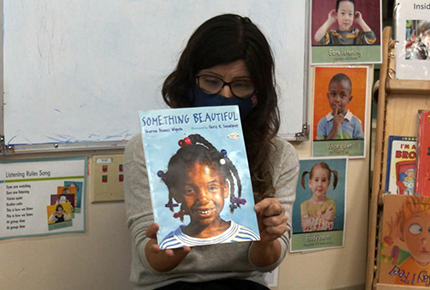Using Children’s Books to Help Build Inclusive Classrooms
Dr. Theresa Bouley, Professor of Early Childhood Education, Eastern Connecticut State University: An inclusive classroom is one where all cultures are represented, all ethnicities are represented, all different family dynamics are represented, all abilities are represented, and not just those that are in the classroom.
Using Children’s Books to Help Build Inclusive Classrooms
Teacher: Right here it says, “We all look alike in my family. We just kind of go together.” So sometimes families look the same. Sometimes they look different. Sometimes they have the same hair color, the same type of hair, the same skin color. Sometimes it’s all different!
Dr. Bouley: Children’s books are a great way to bring in diversity, but to also obviously affirm and represent the diversity that we have in the classroom. I think it’s really important for teachers to stop and really uh look critically at their classroom. Who’s included in your materials, who’s included in your children’s books, who’s not included in your children’s books?
Teacher: (reading) “I rush to open the front door. ‘Tia, Tia!’ I shout. She hugs me and says, ‘Cecelia! Qué pasa? What is this?’”
Dr. Bouley: Seventy five percent of children’s books are actually depicting white families or white people or animals. And out of that 23-ish percent that depict people of color, less than half are actually written by people of color. When we can look for books with authors who represent the culture or the ethnicity, then we know that those books will be more accurate depictions or representations of the culture.
Teacher: (reading) “I see some of my friends. ‘Do you have something beautiful?’ I ask them. ‘I have my jump rope,’ says Sybil. ‘I have my beads,’ says Rebecca. ‘Check out my new shoes!’ says Jamal.”
Dr. Bouley: When children see their family represented in the books that we’re reading, they can develop a sense of pride about their family, feeling comfortable that their family is accepted and recognized and represented and discussed.
Child: Her hair is beautiful.
Teacher: Paityn says her hair is beautiful. I agree. I think her hair is beautiful.
Dr. Bouley: And I also think that it’s really important for all children to see different family structures and backgrounds or to see that there are same-sex families.
Child: They’re going to say, “Goodnight!”
Teacher: Do you think, do your families say, “Goodnight” to you?
Children: Yeah!
Teacher: Just like they’re doing in this book? “One of my dads is tall, and one of my dads is short. They both give me good hugs.”
Dr. Bouley: I think it’s important that we look at books that depict characters who are just doing everyday things—books with characters of all different shades of brown that are actually talking about going on a field trip or losing their first tooth. So the theme is an age-appropriate theme that any child can experience and relate to.
Child: Snow!
Teacher: There was snow! There was snow everywhere!
Dr. Bouley: We have to make sure that we’re not just stocking our library with multicultural books, but we’re also actually using them for our read-alouds and to make sure that we have critical conversations around them, to discuss differences and similarities and inequities. Do some pre-reading activities where you’re setting the stage for children’s interaction and engagement.
Children: ‘Cuz of your hair.
Teacher: Because of my hair!
Dr. Bouley: These kinds of discussions that we have with children before they read the books allows us to sort of continue discussion during and after.
Child: Sad.
Teacher: Yeah, maybe a little bit sad.
Dr. Bouley: It’s the conversations we have around those books that help us to think critically.
Teacher: (reading) “Red bean ice cream is for weirdos.”
Children: Oooooohh.
Dr. Bouley: To help us to develop the vocabulary, to help us feel comfortable having these discussions, to help us to develop children’s sense of empathy. To help them to problematize.
Child: Try to help her to feel better.
Teacher: What a great idea, what a good friend. Sebastian, what would you do if you were in Yoko’s class?
Child: Go tell the principal.
Teacher: Maybe go tell an adult.
Dr. Bouley: So it’s the discussions that we can have around the children’s books that really allow us to further our awareness and our comfort level with diversity and our ability to be change agents.
Teacher: Think about that – powerful. Something that you do that makes you feel strong and powerful. That’s very important that if there’s something you don’t like, then maybe you can find a way to change it.
© 2022 Center for Early Childhood Education at Eastern Connecticut State University
May be reprinted for educational purposes.



